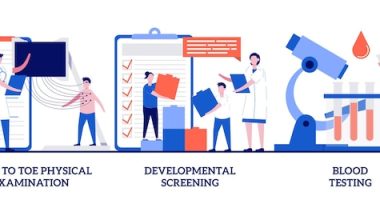In the ever-evolving landscape of medical oncology, a comparative analysis of AML classifications remains pivotal for optimizing patient outcomes. Acute myelogenous leukemia (AML) is a complex hematologic disease characterized by diverse genetic and molecular abnormalities. Recent updates to the classification systems by leading health organizations underscore the necessity for consistent reevaluation to keep pace with advancements in diagnostic and treatment methodologies. This article, authored by Huda Salman, undertakes an in-depth comparison of the World Health Organization (WHO), International Consensus Classification (ICC), and European LeukemiaNet (ELN) frameworks. Significant 2022 updates to these classification systems have enhanced the granularity with which AML is defined, influencing both prognostication and therapeutic approaches. By evaluating the distinctions and alignments across these frameworks, the research illuminates their respective impacts on clinical decision-making and patient management. The analysis aims to clarify the implications of differing blast count criteria, the integration of new genetic markers, and the approach to risk stratification. Understanding these differences is crucial for clinicians worldwide in tailoring treatment plans and improving the overall management of AML, thus enhancing patient care in a tangible, measurable way.
In this comparative analysis of AML classifications, the research delves into the background and evolving paradigms that underscore the importance of nuanced, evidence-based diagnostic frameworks in the management of acute myelogenous leukemia (AML). AML, characterized by the rapid proliferation of abnormal myeloid cells in the bone marrow, presents a complex therapeutic challenge due to its heterogeneity in genetic and molecular profiles. This heterogeneity has necessitated the development of multiple classification systems, each aiming to provide a scaffold that supports precision medicine.
The World Health Organization (WHO), International Consensus Classification (ICC), and European LeukemiaNet (ELN) are at the forefront in establishing comprehensive guidelines that categorize AML types based on genetic, molecular, and phenotypic characteristics. The comparative analysis of AML classifications probes these frameworks to discern the nuances that differentiate them as well as the common threads that weave them together, offering a panoramic view of current strategies in AML categorization and management.
Historically, the classification of AML was primarily based on morphology and cytochemistry, as reflected in the French-American-British (FAB) system which was widely used until the late 1990s. However, the advent of molecular biology and genetics has revolutionized our understanding of AML pathogenesis, leading to an increased focus on genetic abnormalities and their clinical implications. The WHO classification system, first published in 2001 and subsequently updated, integrates both morphologic and molecular genetic information, reflecting this shift towards a more comprehensive diagnostic approach.
The introduction of the ICC in recent years represents another pivotal shift, emphasizing a consensus-based, globally inclusive approach to AML classification. It attempts to harmonize existing frameworks, incorporating robust new data from genetic and clinical studies that enhance the understanding of AML pathology.
Similarly, the ELN guidelines, which are specifically tailored towards therapeutic decision-making, provide criteria for risk stratification and guide treatment based on genetic abnormalities. The 2022 updates to these classifications reflect significant advances in the identification of prognostic markers and targetable mutations, highlighting the dynamic nature of AML research.
By conducting a meticulous comparative analysis of AML classifications, this research aims to illuminate how differences in blast count criteria, the inclusion of new genetic markers, and diverse approaches to risk stratification influence clinical outcomes. This analysis not only helps in understanding how these frameworks adapt to emerging scientific evidence but also in identifying areas where they converge or diverge in their recommendations, thereby impacting clinical decision-making worldwide.
As the field of medical oncology continues to advance, the ongoing refinement of classification systems is vital. By mapping the trajectories of these frameworks, the comparative analysis provides clinicians and researchers with critical insights necessary for tailoring strategies to enhance patient care in AML, aligning diagnostic precision with therapeutic efficacy. This intricate understanding is crucial for the development of personalized medicine approaches that promise to improve outcomes for patients battling this aggressive leukemia.
The methodology employed in this comparative analysis of AML classifications leverages multiple research techniques to explore and elucidate the distinctions and commonalities across the World Health Organization (WHO), International Consensus Classification (ICC), and European LeukemiaNet (ELN) guidelines. To facilitate a comprehensive understanding, the research is structured into several distinct phases:
1. **Literature Review:** A thorough examination of peer-reviewed journals, guidelines, and recent publications forms the foundation of the analysis. This initial review identifies updates in the WHO, ICC, and ELN classifications following their 2022 revisions. It meticulously catalogs advancements in the understanding of molecular genetics and clinical data surrounding AML. Emphasis is placed on understanding the precise implications of updated classification parameters, including blast count criteria and newly identified genetic markers.
2. **Data Extraction and Synthesis:** Information extracted from the literature review is synthesized to pinpoint differences and similarities in classification rationale and methodology between these systems. The comparative analysis of AML classifications focuses on critical aspects such as the definition of disease subtypes, the integration of genetic information, and the stratification of risk, which directly influences therapeutic decision-making.
3. **Expert Consultations:** Engagements with hematologists and oncologists, who routinely apply these classification systems in clinical settings, provide practical insights into how theoretical updates translate into everyday medical practice. This interaction also serves to validate findings from the literature review and data synthesis phases.
4. **Comparative Framework Construction:** Utilizing the data gathered, a framework is constructed that systematically compares each classification system. This involves detailed tables and flowcharts that align corresponding and divergent elements across the WHO, ICC, and ELN criteria. The comparative analysis of AML classifications explicitly outlines how each classification addresses critical clinical questions and patient management.
5. **Analysis of Clinical Impact:** The most significant phase of the methodology assesses the clinical outcomes based on the application of different classification systems. This includes a review of case studies and clinical trial results that illustrate outcomes stemming from the application of specific classification guidelines in treatment planning and execution.
6. **Reporting and Recommendations:** The culmination of the research involves compiling findings into a definitive report that not only contrasts the classification systems but also offers recommendations for harmonizing global AML diagnostic and treatment approaches. This component of the methodology highlights areas where collaborative or unified approaches might enhance patient care.
Throughout the comparative analysis of AML classifications, the study rigorously maintains a balance between detailed scientific evaluation and practical clinical application, ensuring relevance to both the academic oncological community and practicing clinicians. This methodology not only clarifies the landscape of AML classification but also contributes to its evolution by suggesting pathways for integration and improvement in future revisions.
The key findings and results of this pivotal research, centred around the “Comparative analysis of AML classifications,” underline several critical areas where the World Health Organization (WHO), International Consensus Classification (ICC), and European LeukemiaNet (ELN) guidelines diverge and converge in their approach to defining and managing Acute Myelogenous Leukemia (AML). This comparative analysis has highlighted essential disparities and synergies that have significant implications for clinical practice and patient outcomes.
**1. Integration of Genetic Markers:**
A central finding is the varied emphasis and incorporation of genetic markers in the AML classifications. The WHO updates have broadened their genetic markers to include additional fusion genes and mutational spectra, catering to a more granular prognostic stratification. Meanwhile, ELN has more sharply focused on genetic abnormalities directly linked to treatment choices and patient management strategies. The ICC stands out by striving for a global consensus, incorporating widely accepted genetic markers that harmonize with both WHO and ELN but also setting a framework for integrating emerging markers as clinical evidence grows.
**2. Blast Count Criteria:**
The research revealed nuances in blast count criteria, which are pivotal for diagnosing AML. The WHO classification remains more traditional, adhering closely to historical thresholds, whereas the ELN has adopted slightly modified criteria that may influence earlier intervention strategies based on evolving clinical trial evidence. The ICC suggests a more flexible approach determined by associated genetic abnormalities, reflecting a move towards a more individualized diagnosis process.
**3. Risk Stratification and Clinical Impact:**
Another critical aspect noted in the comparative analysis of AML classifications is the approach to risk stratification. ELN’s robust guidelines for risk assessment are meticulously designed to guide therapeutic decisions, something that is less pronounced in WHO but is becoming more structured with their latest revisions. The ICC’s approach to risk incorporates a holistic view, considering both genetic and clinical data, providing a broad framework suitable for variable resource settings globally.
**4. Practical Application in Clinical Settings:**
Insights from expert consultations highlighted in the research indicate that while all three classification systems are grounded in enhancing patient outcomes, the practical application varies significantly by region and availability of diagnostic tools. Discrepancies in the adoption of these guidelines can lead to variabilities in treatment outcomes and emphasize the need for a unified global strategy, particularly in lower-resource settings.
**5. Recommendations for Future Revisions:**
The research suggests that future revisions of these classifications incorporate more dynamic, data-driven criteria that can adapt to rapid advancements in genetic research and drug development. A move towards a more integrated global system could also enhance consistency in AML treatment worldwide.
Through the comparative analysis of AML classifications, this study not only casts a spotlight on the critical differences and potential areas for alignment among the WHO, ICC, and ELN guidelines but also sets the stage for future collaborative efforts to standardize AML classification and treatment approaches globally. This reconciled approach could streamline clinical decisions and foster more personalized, effective treatment strategies for AML patients, ultimately improving survival rates and quality of life.
The study presented here, a “Comparative analysis of AML classifications,” underscores a pivotal moment in the field of medical oncology. The findings demonstrate the advancing frontiers of diagnostic capabilities and the necessity for evolving therapeutic approaches in acute myelogenous leukemia (AML). With each classification system—the WHO, ICC, and ELN—bringing a unique perspective to the diagnosis and management of AML, the importance of aligning these systems becomes apparent to not only optimize patient care but also to streamline global health practices.
The disparities and commonalities highlighted in this comparative analysis provide a roadmap for future revisions of classification guidelines. The adoption of a more integrative approach that encompasses emerging genetic markers and adapts to new therapeutic strategies will be crucial. Additionally, harmonizing these classification systems could mitigate the variability in treatment outcomes, particularly in disparate healthcare settings worldwide. By focusing on these aspects, future frameworks can offer more personalized and precise management strategies for patients with AML.
Moving forward, it is imperative that ongoing research and clinical trials continue to feed into these classification systems. The dynamic nature of AML, with its varied genetic landscape and clinical behavior, demands a responsive and flexible classification system that can adapt to new discoveries and translate them into clinical practice swiftly. The role of international collaborations cannot be overstressed, as these partnerships forge pathways to unified diagnostic and treatment strategies that transcend geographical and economic barriers, promoting equity in healthcare access and outcomes.
The “Comparative analysis of AML classifications” also sets the stage for incorporating advancements in artificial intelligence and machine learning in processing vast arrays of genetic data, which could further refine risk stratification and treatment personalization. These technologies promise to enhance the predictive accuracy of AML classifications and help in the development of novel therapeutic targets.
In conclusion, this comprehensive comparative analysis of AML classifications not only elucidates the current landscape but also highlights the compelling need for a concerted global effort to update and unify these frameworks. As these classification systems evolve, they must remain attuned to the rapid pace of scientific discovery and the shifting paradigms of patient care needs. The integration of newer genetic information, alongside a commitment to global collaboration, will be essential in crafting the next generation of AML classification systems. Such efforts are crucial not only for enhancing the precision of diagnosis and the efficacy of treatment but also for ultimately improving the survival rates and quality of life for patients battling this challenging and diverse disease.









